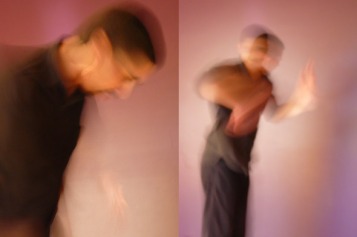I preface these comments by saying that I have omitted some important details from what follows and edited what remains to make sense in light of these omissions. The elements omitted are simply too personal and/or too way out for me to want to share to the whole of the internet. What remains will, I hope, prove to be of interest nevertheless.
In the last few years I’ve had four particularly magical dreams. In these four dreams the experience was so vivid that it felt as though my physical body were in the dream. At the end of several of these dreams, figures from the dreams have remained once I’ve woken up and continued to very tangibly communicate with me.
These dreams aren’t a result of my attempts to develop my spiritual power or use ritual to contact spiritual or magical forces. They fall more into the category of spontaneous experiences that Bil Linzie says distinguish his notion of “real” seidh from the more structured practices performed by groups like Hrafnar.
I should emphasise that even though these dreams (and other experiences I’ve had) probably place me more in the Bil Linzie camp in terms of the kind of seidh I’ve known, I disagree with his view that more considered or consciously constructed seidh work is necessarily inferior.
The first three dreams happened in the space of a week back in 2006. I will only give a short synopsis of each.
First Dream:
In the first I found myself part of a choir that was to perform at a strange concert on a boat in Sydney Harbour. One of my fellow singers was a very intriguing woman who seemed completely larger than life. Her radiance and spirit made everything around her seem completely dull. I felt immediately drawn to her.
After the rehearsal it occurred to me that no one had explained the money side of things to this gig (which I had after all just suddenly found myself in the midst of rehearsing for). This was my excuse to talk to the intriguing woman.
I ran after her and asked her about how we would get paid. She did not know, it turned out, but was loathe to part ways with me. In fact she simply stated that she wanted to stay with me forever! I must admit to feeling overwhelmed with desire for this being, whose radiant aura so thoroughly outshone everything and everyone around
her.
But although it was clear by now that she was non-human and that, despite how real it felt, I was probably dreaming, I could not accept her offer – in particular, because I am married and I love my wife! I stood fast and so we parted ways, though it seemed this would not be the last time I would meet this being.
Second Dream:
I am visiting my father. A pall comes over him and, like a lashing dragon (which is certainly something like how he can be in reality), he starts tearing strips off every decision and act I’ve ever made. My career, my interests, my marriage, you name it – even things that are out of my control (such as my musical taste)!
I am overcome with hurt and rage and then chaos breaks loose. The fabric of the dream tears and everything is destroyed, my entire worldly existence and all markers thereof.
It seems there is a theme here, one which I had not previously noticed – namely that both the woman and my dream-father sought to pull me away from my material, earthly life and point me to different horizons. Their means – seduction and violence – differed of course, but perhaps the intention was the same.
Third Dream:
I find myself living out a series of life-spans. In each life span I face some terrible struggle and I am defeated – only to be reborn again, and again, and again, and again. The life spans zip by faster and faster as I become more and more bewildered by their endless torrent.
Finally I find myself in a strange parallel reality in which we have to remake one of the Rambo films on an alien planet and I have to play the lead role – except there is no acting, it is all real. Thus I find myself in an extra-terrestrial jungle, questing for who knows what.
I am ambushed by the tree-dwelling alien locals and after a swift battle they subdue me. They inform me that I am to be initiated into a very high mystery. I am forced to ingest poison and black out.
Then I am in a strange multi-dimensional open space which I cannot describe. To my right and left are scintillating beings of pure power and the two of them hold me up. We are hurtling through this strange space, the flight seemingly powered by the blazing energies that pour off them.
These two being pass me through a series of initiations, as my perspective becomes broader, and richer, and more expansive. They explain that they have come to assist me on my way through existence. I ask them what their names are. Odin? Freya? All of these – and more – they reply, smirking at my earthling provinciality.
I don’t really understand how they can both be and not be my ancestral gods, but somehow I am deeply convinced. They explain they are taking me somewhere important.
Then I wake up in what seems like the house where my band-mates in Ironwood live, an old and dilapidated home of faded glory. Except in this dreaming reality it is far larger, more ramshackle, and more eerily gothic than in real life.
I somehow know that I must seek out something in this house, something which I will know only when I find it. And so I find myself exploring dark tunnels, strange stairwells, a whole mould-covered, shadow-drenched universe of mystery. Dangerous beings abound and I realise that my time is running out.
Finally I come into a large hall, the ceiling lost in darkness. There is someone else here, but they are invisible. A ghost. He tells me a terrible tale through ethereal sobs. Once he had a daughter but then through his arrogance and foolishness she was lost to him. And he has worn himself almost to nothingness seeking her.
I realise that, somehow, this ghost and I are connected or related. It is a kind of ancestor to me, passing on a torch and a challenge.
Suddenly, I am awake – for real awake. My body is on fire with energy. But the ghost is still there! I hear his voice as clearly as I would a physical human being: “the challenge is passed on to you now”. The challenge to seek out whatever it is that his daughter represents.
In the months after these dreams I generally lapsed into a rather non-spiritual phase, mostly due to a number of very difficult challenges that entered my life financially and so forth.
But since I met Donovan my spirituality has been getting fed a lot more regularly, and starting Elhaz Ablaze has forced me to open into the stream of magic even more – after all if I am going to have a regular column then I need to have something to write about, and I would much rather write (and read) about practical experiences than my opinions and beliefs.
I think this renewed attention to this part of myself has created a fertile ground for the deeper aspects of my being to awaken again as they were back in 2006. Reading a lot of James Hillman’s work has also had a critical impact on this re-awakening. I think his work should be mandatory for all heathens to read, even though he isn’t a heathen but rather a psychological polytheist. Start with A Blue Fire
and go from there!
Heading into Yule this year I started having very strange and wild dreams and I knew some strange new upheaval was coming towards me.
A few weeks before Yule I fell very sick and became quite depressed for a little while as a result. It was a very hard thing but I have learned that you come back from the depths if you have patience and a little contempt for the ego’s mind games.
On the day of the Yule celebration I was very sick in the stomach and spent most of the day vomiting.
We couldn’t figure out what was the cause except the vague possibility of food poisoning. Eventually I must have thrown up whatever caused the problem however because just as the Yule festivities were due to begin I suddenly completely recovered.
While I was sick during that day I wandered through all kinds of strange worlds, and in particular the dark lands of Helheim. Freya appeared to me and she told me that I was in a process. I had died one death with my recent sickness, and this illness and attendant world-walking was a second death. She warned that I would have to die one more death yet.
Incidentally, this little but of Unsubstantiated Personal Gnosis (UPG) seems to fit with the idea that Freya is identical with Gullveig, the volva who the gods destroy three times by fire – and who is then reborn as Heidh, the Shining. Who would be more likely to come to tell me I was undergoing a somewhat similar process of
triple death?
After Yule I continued to have many wild and strange dreams – until a few weeks ago when I had the fourth of my significant dreams – and the third of the three deaths Freya spoke of.
The last night of dreaming I had series of intensely embodied dreams. In them I had to pass all sorts of tests and challenges, in all kinds of identities. In some cases it was members of my family that set the challenges.
After completing many of these tests I started to be overcome with déjà vu – indeed, it felt as though I had actually done every one of these tests many times over in the past.
The realisation woke up – and on either side of me there was a being composed of intense white light. The two beings started to speak to me. They were quite circuitous in their manner of speaking and very direct.
After a great deal of negotiation they agreed to permit me to refer to them as Fire and Water. They were the woman in the first dream, my father in the second, and the two great beings in the third dream.
Fire and Water are like trans-mythological beings, who predate even my heathen ancestral gods. They represent a distilled expression of divinity – at least insofar as I am able to experience it.
They told me that, though I might not know it, my task in this life is to bring together the riches of my internal spiritual life with the physical realities of finite existence. To me this is a great challenge but they were very certain that watching me would be an interesting exercise!
By passing the challenges of my dreams it seems I have been granted the perspective on life that they were trying to give me those years ago through seduction and destruction. This was the third death – the death of my limited horizons. I think that this in turn frees me to seek whatever the “daughter” in my third dream represents.
There were other things too but I won’t go into that here.
As I’ve mentioned before, I’ve had some spontaneous experiences in the last year that could have come straight out of an alchemy handbook. On a whim I therefore did some research – and discovered that alchemical Mercury is the union of Fire and Water, and of Spirit and Matter. Given that Mercury and Woden are cousins this explains a lot about my connection to the latter.
Since that experience a month or two ago I have been feeling myself changing, becoming more confident, or at least less enslaved to my limitations. The full consequences of these experiences are still unfolding. I don’t know if I should describe them as “real” or “psychological” or something else, but I do know that their consequences are proving to be highly positive.
Of course, Fire and Water do not exactly have a home in heathen mythology, but their existence does make me ponder the nature of the boundaries of any set of myths.
Insofar as any mythology is a cultural expression of mysteries which are (at least somewhat) beyond human comprehension, I find myself reaffirming the importance of heathenism being more than cultural/practical reconstruction.
Fire and Water seem to consider themselves as trans-cultural, able to manifest in a variety of unique and individual ways. I think it is a bit like how for the ancient Greeks the gods often had to be met in very specific manifestations.
Thus they had, for example, the Temple of Zeus at Athens. Now Zeus at Athens is a different entity to Zeus at Sparta from what I understand, even though they are nevertheless both Zeus. This kind of looseness around the distinction between universal and particular seems a common hallmark of polytheism, especially Indo-European polytheism (look at all of Odin’s identities or the many incarnations of the Hindu deities).
Our ancestors lived on the horizon of the unknown; introducing border-dwelling into our own lives is just as important as reconstructing the communal/cultural dimensions of heathenism – otherwise we risk modern heathenry becoming a caricature of the old ways, not their rebirth.
Furthermore, when the unconscious/deep mind/magical beings/gods/whatever speak (choose-your-own-belief-system), they may or may not have a concern for our beliefs about how things are or should be. In order to respect them and allow them to help us grow or transform or distil we need to be open to possibilities that our conscious (ego) reconstructions might not anticipate.
The well known chaos magician Fenwick Rysen has written about Fire and Water as essential forces in his spirituality. I’ve not been able to contact him but I’d love to see what he would make of the experiences I have described.
For me I know that Fire and Water are essential parts of who I am – and their presence changes my heathenry for the better, even though they appear in no historical manual and no Eddic poem. I’ve never incorporated such wholesale UPG into my spirituality before but it seems right.
Such mysterious and elemental beings certainly would not seem out of place in the old poems, although their machinations probably work in a different context to the Aesir, Vanir and Jotnar. And of course, Freyja knows about them and predicted their coming too.
It’s often been pointed out that the heathen lore we still have was once the UPG of our ancestors. It’s important to keep the difference between our and their creations clear so that others are not misled, but that said it would be a sad reconstruction of heathenry that we engage in if we do not do as they did and delve into the realms of magical experience with trust that those experiences are meaningful.
Fire and Water might also be found in the more purely animistic beliefs that polytheism proper grew out of. They certainly have opened a door for me into a wider, darker and richer world.
Neurosis sing:
We stand encircled by wing and fire
Our deepest ties return and turn upon us
Heathenry might be about finding ourselves here and now in the grand weave of history and life, rather than slumbering in disconnected numbness. If this is so then Fire and Water, and the entire process I am experiencing, are about as heathen as you can get.
I’d like to conclude this article with some of the lyrics I wrote for our forthcoming Ironwood album :Fire:Water:Ash: (incidentally the title of the album and the reference to fire and water in the lyrics occurred prior to my encounter with Fire and Water, though with hindsight it all seems connected).
The Serpent Seeks its Tail
Streams of steaming ice
Streams of molten flame
Compelled to clash
In the whirling halls of chaos
Is this a creation myth?
Screeching atomic tide
Stars blaze with insanity
In generation destruction delights
Formed by ice, forged by flame
Frail mortal breathing
Lathed by salt, poison laced
Frail mortal dreaming
Is this a parable?
An endlessly retold tale
A failed symbol for moment:
Thus untamed is time
Nature dismissed as nothing
Ancient Ur-laws lost, defied
Can you remember your own being?
Where does your weary heart hide?
A glimpse of boiling Ginnung
Sloughs off this armoured weight
Purging power of Salt,
Fire, Water and Ash
Dismiss with contempt
The false forms you hold
Become what you are
Become what you must be
Destroyed by ice, destroyed by flame
Frail mortal breathing
Lathed by salt, poison laced
This frail mortal dreaming





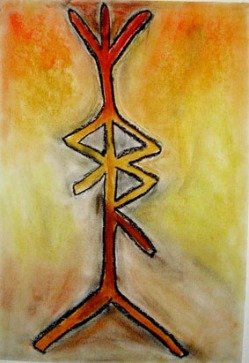 This first rune sigil is one of my “don’t remember what it means” specials. I used an Indian snake skin tambourine to send it off, dancing, singing, drumming, you name it, until I was frothing and spasming and seething madly. Odin appeared at various points and lectured me about various things I didn’t understanding – perhaps related somehow to the meaning of the bind rune.
This first rune sigil is one of my “don’t remember what it means” specials. I used an Indian snake skin tambourine to send it off, dancing, singing, drumming, you name it, until I was frothing and spasming and seething madly. Odin appeared at various points and lectured me about various things I didn’t understanding – perhaps related somehow to the meaning of the bind rune.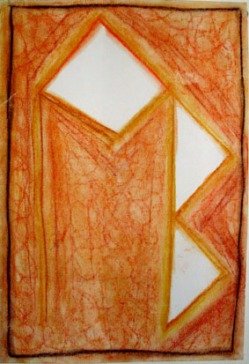 I’m no Sheehan but I have a few tricks up my sleeve. The magic kicked in really hard once I got my feet stamping in 4:4 time, then my left hand cutting across that on the tambourine in what I think was a 12:8, and then my right hand banging away on the tambourine for a while in 5:4, then 7:8 and 9:8. I used my forearms to loosely hold the tambourine across my chest as I did this so that the rhythms were very physical, tangible, for me.
I’m no Sheehan but I have a few tricks up my sleeve. The magic kicked in really hard once I got my feet stamping in 4:4 time, then my left hand cutting across that on the tambourine in what I think was a 12:8, and then my right hand banging away on the tambourine for a while in 5:4, then 7:8 and 9:8. I used my forearms to loosely hold the tambourine across my chest as I did this so that the rhythms were very physical, tangible, for me.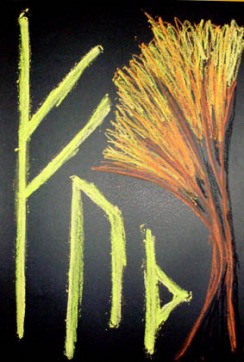 Well I’ve been firing off a few more sigils, so here they are. I worked out a whole stack of runic combinations for various purposes and am now working through designing them and activating them. As this post is pretty much a report on recent activities it should be classed as mostly UPG, albeit UPG informed by knowledge of historical sources.
Well I’ve been firing off a few more sigils, so here they are. I worked out a whole stack of runic combinations for various purposes and am now working through designing them and activating them. As this post is pretty much a report on recent activities it should be classed as mostly UPG, albeit UPG informed by knowledge of historical sources.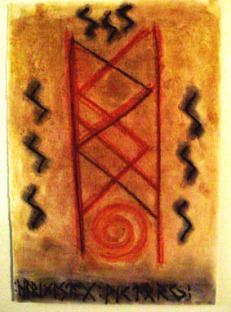 The magic to release this sigil into the world got a bit crazy.
The magic to release this sigil into the world got a bit crazy.